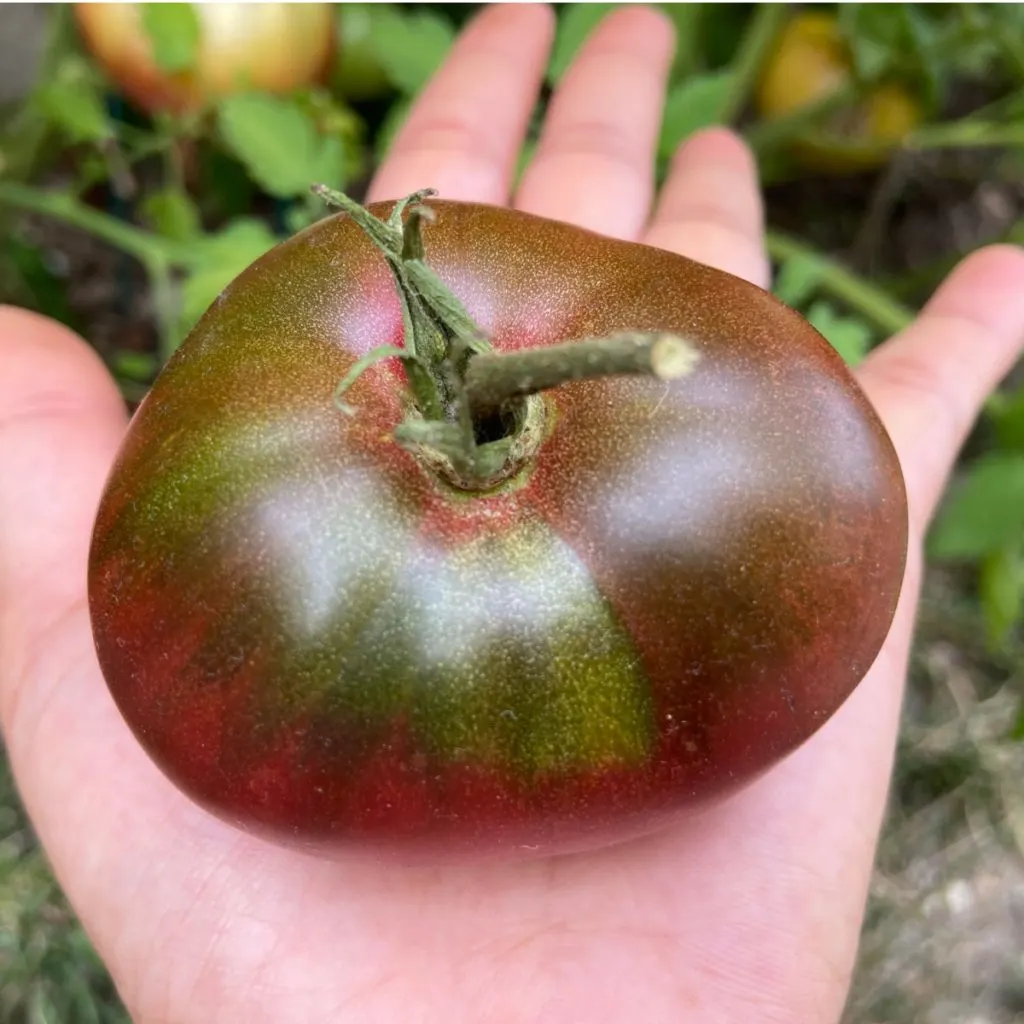When it comes to one of the most flavorful and beautiful tomatoes you can have in your garden, it’s hard to beat growing the incredible heirloom Cherokee Purple tomato!
This large, beefsteak-style tomato matures to a deep burgundy color on its outer skin. But it’s when you slice into this meaty tomato the real magic happens. The tomato almost oozes with flavor. In fact, the deep, dark, reddish marbled flesh almost gives away its sweet, juicy taste before you even bite into it.
Cherokee Purple tomatoes are versatile as well. Their large slicing size makes them perfect for topping hamburgers and sandwiches, but they are perfect in salads, for canning, or even for cooking with as well. Their rich flavor and deep color truly make them a unique tomato variety to add to almost any dish.

The Origins Of The Cherokee Purple
As with so many heirloom tomatoes, this tomato’s history is almost as interesting as its color and flavor. It’s been said that the Cherokee Purple’s seed was given its official name in the 1990s based on the information found inside of its seed packet.
The original seeds were thought to have come from Kentucky along with a note explaining that long ago, the fruits were possibly grown by members of the Cherokee nation. Although legends and folklore are hard to prove, one thing is for sure, these award-winning tomatoes are very real!
They are an extremely nutritious tomato as they are filled with antioxidants and minerals that are great for heart health. Because of the deep colors in Cherokee Purple tomatoes, they are even more rich in vitamins C, K and A as well.
Growing Cherokee Purple Tomatoes
Starting Seeds & Transplants
Like so many heirloom varieties, Cherokee Purple continues to increase in popularity with each passing year. Because of that, it has become a bit easier to find transplants in the spring at local nurseries and even big box stores.
If growing your own plants from seed, you will want to order and have seeds on hand early. Start plants indoors eight weeks before your expected outdoor planting date. The Cherokee takes about 75 to 85 days from seed to fruit, so getting a head start can help overall production.

The good news is that this heirloom is an indeterminate variety. That means once it starts producing its fruit, it will continue to do so until the first hard frost in the fall takes it out.
Planting – Growing Cherokee Purple
Cherokee Purple tomatoes have quite a strong root system. Their roots, stems and fruits can grow large and produce quite a heavy harvest. Because of this, they need to grow in a traditional garden or raised bed system. They are not a good candidate for growing in containers.
Like most typical tomato plants, Cherokee tomatoes need a lot of warmth and sun. Plant in a location that receives at least six to eight full hours of sunlight. If they get more, they will perform even better.
When planting, give these tomatoes a lot of nutrients to help right from the start. Plant transplants deep, adding in generous amounts of compost to each planting hole. Cherokee tomatoes are big feeders from the soil, and compost can help provide extra nutrition as they establish.
At full maturity, the plants can grow to 5′ or more in height and easily 3′ wide. With this in mind, allow plenty of room between additional plants for good airflow and pollination.
Listen In Below On Our Podcast On How To Jump Start Your Tomato Plants!
With their massive size, they will need to have support in the way of a stake or cage. As always, when planting tomatoes, get the support in the ground at planting time. This will help support plants early, but more importantly, prevent damage to growing roots if supports are driven in later after the plants establish in the soil.
Watering & Fertilizing – Growing Cherokee Purple
From a watering standpoint, Cherokee Purple needs to have an average of about 1 to 1.5 inches of water per week for best results. With its large, meaty interior, if it fails to get enough water, the size and quality of the harvest will be affected.
Mulching these plants is always a great idea. Not only to help conserve moisture in the soil, but to help keep competing weeds to a minimum. Mulch deep, using straw, shredded leaves or grass clippings to a depth of four to five inches.
As for fertilizing, it’s better to provide Cherokee Purple with consistent and steady doses of energy than large, single bursts of power. Fertilize your plants every two weeks. Compost tea works well for this, as will a good organic liquid fertilizer.
Liquid fertilizers provide faster nutrient feedings to your plants than granular. They also absorb into plants both through the roots and through the stems and foliage. Affiliate Link: Espoma Organic 8 Ounce Concentrated Tomato!
Pruning & Picking – Growing Cherokee Purple Tomatoes
With Cherokee tomatoes, pruning can go a long way toward helping your plants stay healthy and strong. These massive plants have a tendency to overgrow foliage, especially near the bottom of the plant. By pruning up underneath plants 12 to 18 inches as they grow, you will help improve airflow. This also makes watering a much easier chore!
Purple Cherokee plants will not produce a huge rush of fruit all at once. But the size and longevity of the plant more than make up for an all-at-once harvest. Tomatoes are ripe once they reach a deep burgundy color and are slightly soft to the touch. You can pick and let ripen off the plant as soon as the fruit begins to change color. See How To Know When To Pick Tomatoes At The Right Time.

Here is to growing Cherokee Purple in your garden this year – and enjoying the fruits of your labor all summer long!
Follow Our Facebook Page For Even More Great Tomato Growing Tips! I Grow Tomatoes Facebook Page
I Grow Tomatoes is a website created for those who love all things about tomatoes – from planting and growing – to cooking and canning! We publish two articles every week, 52 weeks a year. Sign up today to follow via email! This article may contain affiliate links.

